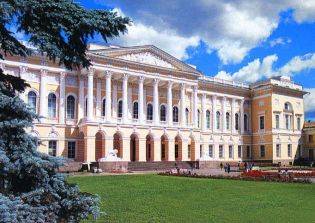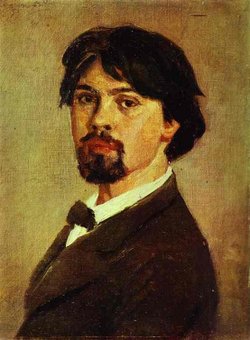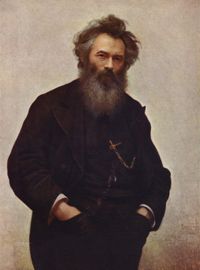На домашнюю страничку
Дистанционный урок в рамках факультативного курса «Искусство»
по английскому языку по теме «Русские художники. Передвижники»
(“Russian painting. Peredvizhniki”)
тема «Русские художники. Передвижники».
Класс: 8 «Г» (гимназический класс)
Форма урока: урок с использованием поисковых систем
Тип урока: закрепления знаний и формирования умений, обобщения и систематизации знаний.
Цель урока для учащихся:
Задачи урока:
Ожидаемый результат работы:
ТСО на уроке: компьютер с выходом в Интернет
Время урока: 2 урока по 45 минут.
План работы на уроке:
Дистанционный урок, предлагаемый Вашему вниманию, является уроком закрепления знаний и формирования умений, обобщения и систематизации знаний в курсе «Russian painting» и предполагает следующие стадии работы:
1. Теоретическая - вы читаете учебные материалы на его страницах данного курса и просматриваете созданную мною презентацию по творчеству Д.Левицкого.
2. Практическая - вы выполняете задания 1 – 7 (Task 1-7), ищите ответы на вопросы на страницах WWW, отвечаете письменно в тетрадке;
3. Лабораторно-практическая - вы создаете презентацию о творчестве одного из полюбившегося Вам художника, для этого по мере прочтения теоретической части сохраняете у себя на компьютере фотографии, представленные на страницах WWW;
4. Проверочная - отвечаете на вопросы теста для самоконтроля;
Презентация должна иметь не менее 7- 9 слайдов с текстом и фотографиями.
Структура презентации:
Слайд 1: информация о Вас и название Вашей презентации.
Слайд 2-3: общая информация о Передвижниках.
Слайд 4-8: информация о выбранном художнике.
Слайд 9: ссылка на источники.
На следующих уроках мы продолжим создание презентаций по английским художникам.
Если у вас возникают вопросы по тексту урока, по работе со страницами WWW, в том числе с поисковыми серверами, или по созданию презентации, вы можете задать свои вопросы мне по e-mail: osuvertok@rambler.ru
Если Вы закончите работу раньше отведенного времени, пройдите на экскурсию по Русскому музею или Третьяковской галерее для осмотра работ художников.
Время работы – 5 мин.
 |
 |
| St Tretyakov Gallery | Russian Museum |
| http://www.tretyakov.ru/ | http://www.rusmuseum.ru/ru/collections/ |
“Russian painting. Peredvizhniki”
Ход урока:At our lesson we’re going to speak about Russian painters the so-called Peredvizhniki (Wanderers) who wrote landscapes at the end of the nineteenth-century.
The second half of the nineteenth century is represented particularly comprehensively in the Tretyakov Gallery. Here we can find almost all notable artists of the day, represented by their most interesting and significant works.
This era in Russian art was distinguished by realism that devoted particular attention to the depiction of the nation’s social existence. A truly national tradition didn’t begin until 1870 with the appearance of the “Wanderers” – the Peredvizhniki. This society was formed by a group of Romantic artists who regarded thmselves as Realists. They rejected the restrictive and foreign – inspired classicism of the Russian Academy to form a new realist and nationalist art that would serve the common men.
Forming the Society of Wandering Exhibitions, they organized mobile exhibitions of their works in an effort to bring serious art to the people. The most prominent Russian artists of the 1860 - 1880s are I.Kramskoy, V.Surikov, V.Perov V.Vereshchagin, A.Kuindzi, I.Shisnkin...
 |
 |
 |
Task 1.
Find out the names and the portraits of the Peredvizhniki
http://rusart.nm.ru/
What museums in Moscow and Saint Petersburg have got the paintings of the Peredvizniki?
http://www.rusmuseum.ru/ru/collections/
http://www.tretyakov.ru/
Время работы – 10 мин.
And now let’s speak about some of them.
Ivan Nikolaevich Kramskoy
Among the Russian representatives of the Wanderers one of the most significant and respectable is Ivan Nikolaevich Kramskoy. Ivan Kramskoy came from a remote province of St. Petersburg Ostrogozhsk where he spent his youth. On finishing the province gymnasium with honours he entered the Academy of Arts. While studying at the Academy he paid a lot of attention to self-education in philosophy, history, literature that formed his ideology, his aesthetic views.In November 1863 the students of the Academy (and Kramskoy among them) organised a protest against mythological themes in the competition for the Great Gold Medal that gave a six-year scholarship to study abroad. As a result, the talented young painters were expelled from the Academy.
Then he had very hard time, generously helped his friends, gave lessons and made retouching. To survive, he had to work 14-16 hours a day, more and more he painted orded portraits, but he never demoted art to trade and all his paintings were original and distinctive. By this time Kramskoy was paid 5000 roubles a painting.
Task 2.
Find out more information about Kramskoy’s childhood.
http://rusart.nm.ru/pages/gallery.html
Время работы – 10 мин.
Now we’re going to describe some his paintings.
«The Unknown».
A misty winter day in St. Petersburg. A young proud woman in an open carriage is depicted on the background of the Anichkov Palace. Her dark eyes, set into a frame of thick eyelashes, are a little arrogant and sad. She’s wearing a velvet suit with fur cuffs and a small hat decorated by ostrich feather. A thin hand is in a kid glove. The painter created the image of enigmatic charm. Who’s the woman? Nobody knows. Kramskoy wanted to portray an image with spiritual beauty.
Task 3.
Find the painting.
http://www.artlib.ru/
Время работы – 5 мин.
“Leo Tolstoy”
In the portraits Kramskoy tried to find his own artistic methods, different from Rembrandt, Titsyan and others. The canvas portraying “Leo Tolstoy” was made in Yasnaya Polyana, when the great writer was 45 years old in the prime of his creative life.
The composition of the canvas is quite common with prevailing shadows of olive. Tolstoy is dressed in a common working blouse without any noticeable details so the observer’s attention is concentrated on the writer’s face, on his eyes. The Tolstoy’s intent view penetrates into observer’s consciousness; he shares his thoughts about sense of his life with us.
«Christ in the Wilderness»
In “Christ in the Wilderness” he turned to the episode of the Gospel legends about Christ. During the 40 days’ staying of Christ in the wilderness he painfully thinks about the future, about the faith for which he was ready to give his life.
In the painting the Teacher with a thoughtful face sits on a rock, his hands are clasped. As Kramskoi asserted, he wanted to bring to the viewer a sense of Christ’s moral choice between serving the ideal or adhering to private concerns. For the artist Christ is the embodiment of people’s conscience and honor.
Task 4.
Find the paintings. Do you agree with the descriptions? Can you add anything?
http://www.artlib.ru/
Время работы – 10 мин.
Vasily Polenov
Vasily Polenov was born in an intelligent nobel family, his father was a historic-archeologist, his mother was an artist. Polenov had both scientific and artistic talents. In the childhood he was greatly influenced by outstanding Russian nature and Ivanov’s masterpiece “Christ appearing the people”.He studied at the St. Petersburg university and got a diploma of a lawyer at the Academy of Art and won the Big Gold Medal for “Resurrection of Javir’s daughter”, which granted him study abroad.
On his returning home he created “Moscow yard”, “Grandmother’s garden” and became one of the best Russian landscape painters. Later Polenov was dreaming to follow Ivanov’s profound philosophical idea – to create the image of Christ but not just coming to the people. Christ accomplishing his way among the people. Ivanov couldn’t visit Palestina but Polenov had opportunity to go there twice and as a result of it he created his biggest painting “Christ and a Sinner” and then some others.
Now in Borok on the river Ob’ Polenov’s museum is opened.
Task 5.
Find Polenov’s paintings “The Moscow yard” and “The overgrown pond” and try to desribe one of them.
http://www.artlib.ru/
Время работы – 10-13 мин.
Task 6.
Read the describtion of the following painting and guess the author.
“March”
Yearly spring is a very dull time in Russia because summer seems to be very far away and you remember only cold winter days. Neither rare sunny days, nor swelling buds can rejoice you. March is an artful month: cold wind will blow and the buds will turn into icicles and heavy low clouds will cover the sky.
In spite of a lot of sunny light his painting “March” the viewer feels a light oppressing sorrow, he understands that spring is too far and there are very many gloomy days before it comes.
http://sch1262.ru/
Have you managed to guess the painter? I’m sure you have! Then do the next task as your homework.
Task 7.
1. Find the painting “March” and write the biography of the painter.
http://sch1262.ru/levitan/index.html
2. Find 2 more masterpieces of this painter.
Время работы –15 мин.
Start working at your presentation “Russian painters. Peredvizhniki”
1.Choose the painter:
http://www.rollins.edu/ http://www.5ka.ru/
http://www.artlib.ru/
http://sch1262.ru/
2. Slide1: Put general information about yourself and the name of your presentation
3. Slide 2: Put information about the Peredvizhmiki.
http://rusart.nm.ru/
4. Study presentation “Russian painting. Dmitry Levitsky” (as an example).
http://english4every1.narod.ru/
(презентация “Russian painting”)
Время работы – 10-15 мин
Homework:
Make the presentation of one of the Peredvizhniki.
На домашнюю страничку
Используются технологии uCoz